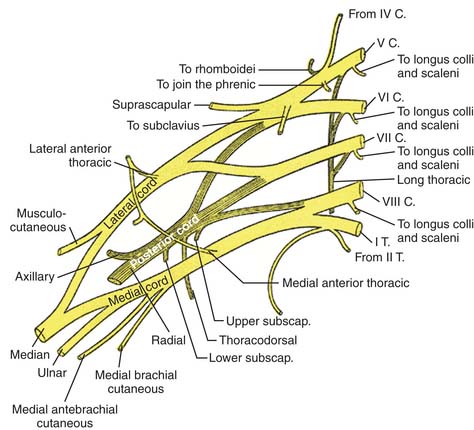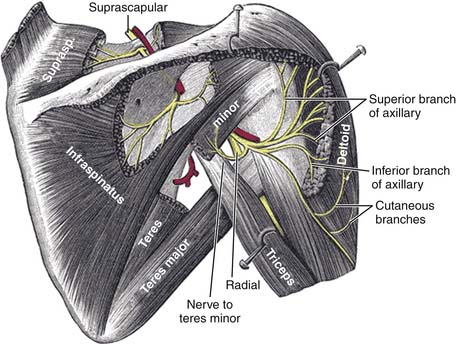25 Suprascapular Nerve Block
Anatomy of the Suprascapular Nerve
The suprascapular nerve is a mixed motor and sensory peripheral nerve originating from the upper trunk of the brachial plexus, receiving contributions predominantly from C5 and C6 fibers with approximately 22% of individuals also receiving contributions from C4.1 The suprascapular nerve gives motor innervation to the supraspinatus and infraspinatus muscles. Additionally, the nerve gives sensory and proprioceptive innervation to the glenohumeral joint, acromioclavicular joint, subacromial bursa, and the scapula (Fig. 25-1). Although the suprascapular nerve receives afferents from up to 70% of the shoulder joint, it rarely carries cutaneous afferent fibers. Cadaveric studies have found that as many as 15% of individuals have a cutaneous branch of the suprascapular nerve supplying the proximal, lateral one-third of the arm.2,3

Figure 25-1 Brachial plexus.
(From Gray H: Anatomy of the Human Body. Philadelphia, Lea & Febiger, 1918).
After arising from the upper trunk of the brachial plexus, the suprascapular nerve courses through the posterior triangle of the neck, anterior to the trapezius muscle and posterior to the inferior belly of the omohyoid muscle (Fig. 25-2). The nerve then traverses through the suprascapular notch where it lies beneath the superior transverse scapular ligament and in close relation to the posterior border of the clavicle. Proximal to entering the suprascapular notch, the superior articular branch of the suprascapular nerve gives off sensory fibers to the coracoclavicular and coracohumeral ligaments, the acromioclavicular joint, and the subacromial bursa.3–6 Within the suprascapular notch, the suprascapular nerve gives rise to two motor nerves to the supraspinatus muscle.2 The nerve then passes through the notch and continues inferiorly, wrapping around the lateral margin of the scapular spine and through the spinoglenoid notch. Here, the suprascapular nerve sends a sensory branch to the posterior glenohumeral joint capsule. The nerve subsequently travels around the scapular spine, passing through a tunnel created by the spine of the scapula and spinoglenoid ligament (inferior transverse scapular ligament). The spinoglenoid ligament is a fibrous connective tissue band which originates from the lateral border of the scapular spine and inserts at the margin of the glenoid process.6 After passing through this space, the suprascapular nerve terminates by sending two to four motor branches to the infraspinatus muscle.

Figure 25-2 Course of suprascapular nerve on right side.
(From Gray, H: Anatomy of the Human Body. Philadelphia, Lea & Febiger, 1918).
Anatomic associations of the suprascapular nerve play an important role in source of injury. Proximally, the nerve’s close relation to the inferior border of the clavicle makes it potentially vulnerable to clavicular injuries. It is also hypothesized that anatomic variation in the shape of the suprascapular notch may predispose individuals to proximal suprascapular nerve entrapment. Cadaveric studies of adult scapulae have shown that the suprascapular notch can exist in six shapes. The U-shaped (48%) and V-shaped (3%) are most commonly associated with nerve entrapment.2,7 Additionally, morphologic deviations in the superior transverse scapular ligament, such as calcification and hypertrophy, are also associated with suprascapular nerve injury.2
The suprascapular nerve is prone to injury distally where it passes through the tunnel formed by the scapular spine and the spinoglenoid ligament. Adduction and internal rotation of the shoulder is thought to tense the spinoglenoid ligament and subsequently stretch the nerve.2,8 In cadaveric studies, the spinoglenoid ligament has been identified in variable prevalence (15% to 80% of individuals).2,9,10 Interestingly, the ligament has been shown to be present more frequently in males (87%) than in females (50%), representing the higher likelihood of volleyball shoulder in males.6
Pathophysiology
The most common location of injury to the suprascapular nerve is proximally at the suprascapular notch, and distally at the spinoglenoid notch. The mechanism of suprascapular nerve injury here is usually by repetitive overhead motions of the shoulder. In what is termed the sling effect, depression and retraction or hyperabduction of the shoulder causes the nerve to become apposed to the inferior margin of the superior transverse scapular ligament proximally or submitted to traction injury as it wraps around the scapular spine distally at the spinoglenoid notch.2 The sling effect underscores the importance of the scapula in overhead shoulder motions, such as throwing. These upper limb movements, causing scapular protraction and retraction, ultimately cause tension on the suprascapular nerve and sheer stress. Consequently, many suprascapular nerve injuries are in athletes using repetitive overhead motions that stress the shoulder.2
Alternative movements of the shoulder are also associated with distal suprascapular nerve injury. Abduction and external rotation causes the medial border of the infraspinatus tendon, inducing a compression injury at the spinoglenoid notch.2,11 Adduction or internal rotation of the upper limb is thought to cause traction of the suprascapular nerve at the spinoglenoid notch.2,12 Fast, repetitive, eccentric contraction of the infraspinatus muscle, in what is termed “volleyball shoulder”, causes injury to the suprascapular nerve at its terminal portion.13,14
Stay updated, free articles. Join our Telegram channel

Full access? Get Clinical Tree







